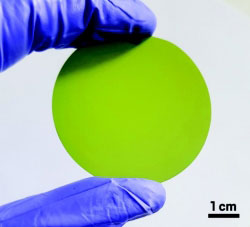Since its discovery in the 1970s, surface-enhanced Raman spectroscopy (SERS) has been used to boost the signal obtained from molecules sitting on rough or finely structured metal surfaces, typically made of either silver or gold. Now, Gokhan Demirel of Gazi University, Hakan Usta of Abdullah Gül University, Antonio Facchetti and George C. Schatz of Northwestern University, and coworkers have achieved signal enhancement using a nanostructured organic semiconductor as a SERS substrate (Nat. Mater. 2017, DOI: 10.1038/nmat4957).
To make the substrate, the researchers start with an organic semiconductor called α,ω-diperfluorohexylquaterthiophene (DFH-4T). It has a core of four thiophene rings and a fluorocarbon chain at both ends. “This molecule is easy to synthesize, and the synthesis can be scaled up,” Usta says. “You can prepare micro- or nanostructured films of DFH-4T very easily” by depositing a vapor of the molecules onto a surface, Demirel adds.

The researchers tweak the conditions conventionally used for physical vapor deposition to make their films. For instance, they move the source of DFH-4T molecules closer to the substrate than normal and use a faster deposition rate. Under these conditions, DFH-4T forms nanostructures consisting of vertically aligned nanoplates connected to a wirelike center. A 5-cm substrate can be coated in just 10 minutes.
The fluorocarbon chains serve multiple purposes. Without them, the resulting films are smooth instead of rough and thus don’t boost the SERS signal. In addition to the nanostructures, the fluorocarbons make the surface extremely hydrophobic, which helps concentrate analyte molecules being studied: Once deposited on the films, droplets containing the analytes stay put rather than spreading.
Modeling by Schatz’s group shows where the enhancement is coming from in the film without the gold. “We found that there’s a charge-transfer state that arises when the analyte interacts with a semiconductor,” Schatz says. “It requires this nice, highly crystalline morphology.”
Organic semiconductors “enrich the palette of materials for obtaining unconventional enhancement of Raman scattering,” says Ivano Alessandri, a SERS expert at the University of Brescia. However, he notes, the enhancement factor of about 3,000 is still quite limited and requires the assistance of plasmonic metals for ultrasensitive analysis.
Facchetti hopes to nudge the SERS enhancement from the semiconductor film upward. He envisions using chemical dopants or external electric fields to add extra electrons that could boost the Raman signal further.
But even if the enhancement factors end up being too small to make the semiconductor films attractive as SERS substrates on their own, the films could make good templates for metal substrates. In that way, researchers could make nanostructured gold surfaces without needing expensive and time-consuming lithography techniques.
